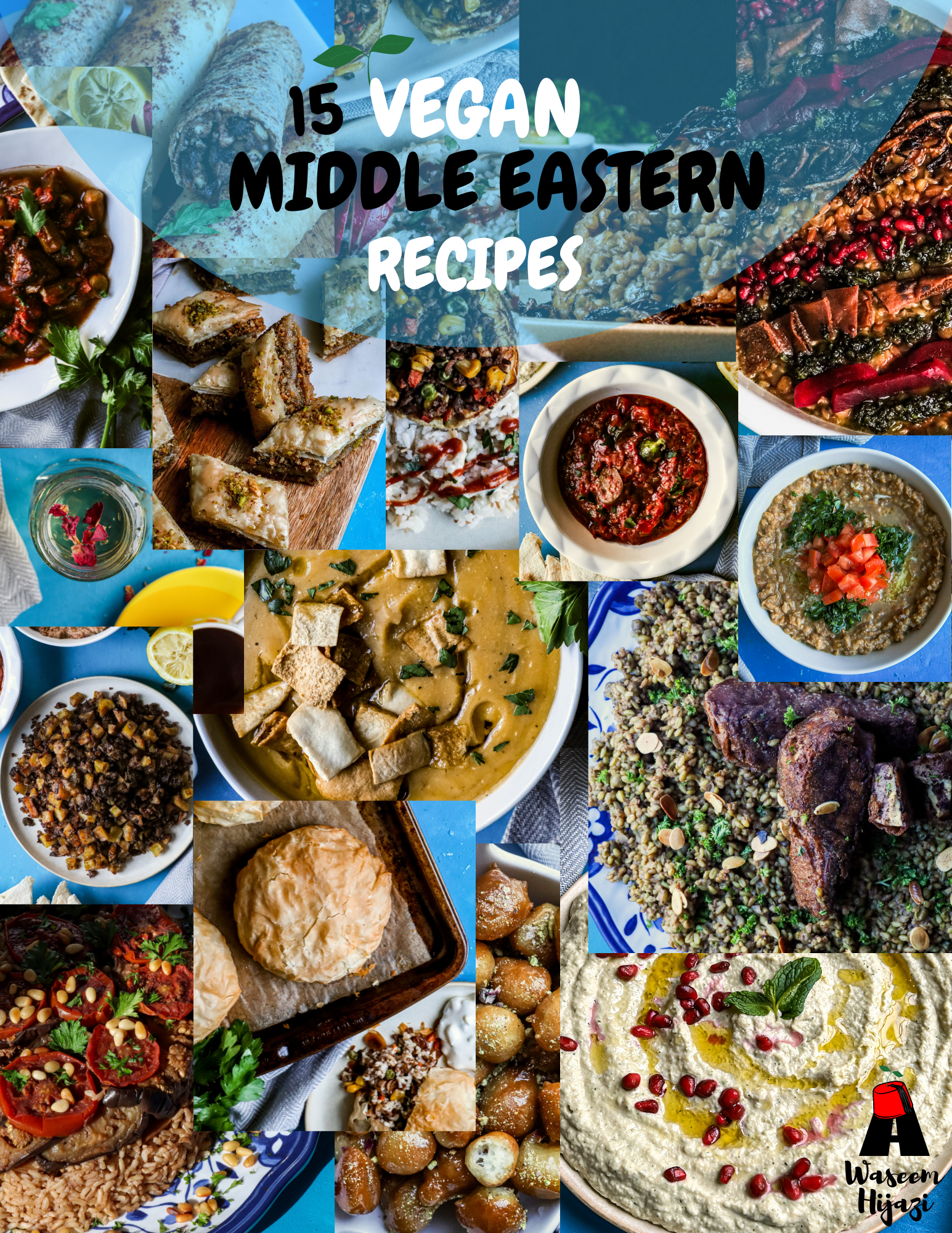These naturally-vegan grape leaves (aka Yalanji) are a wholesome plant-based appetizer. They’re zesty, tangy, and sweet – making them a famous Middle Eastern dish across the cuisine. This Syrian version is a family recipe that I grew up eating with freshly-picked leaves from our garden.

About The Recipe
- Vegetarian | Vegan
- Tangy & zesty
- Meal-prep friendly
- Great party food
- Stuffing for different vegetables

What Is Yalanji?
If there’s one dish I’ll never get bored of, it’s this one!
Yalanji is typically known as the traditional vegetarian stuffed grape leaves. Which are very popular in the Middle East. Commonly served at Lebanese, Syrian, Turkish, and Greek restaurants; amongst many others. They’re also named: Dolma, Yabrak, Waraak Enab, Dolmades, to name a few.

But the word Yalanji mainly refers to the actual filling.
The Turkish meaning of the word is: Lying or Liar. Which is to represent the deceiving filling (being vegetarian [actually vegan] rather than the traditional meat-based filling). In a way, it was like using a ‘fake‘ filling for stuffing and rolling vegetables. Hence the name.
In reality, the recipe itself includes the option to use whatever vegetables you like.
From zucchinis and eggplants, to bell peppers, cabbage leaves, you name it! They make a wonderful appetizer for a great Mezze, or as a mid-day snack.

The Arabic name for this recipe that’s known in the Arab cuisine is Waraak Enab Bil Zeit. Translating to: Grape Leaves In Oil. Referring to the tangy, zesty, oily vegetarian grape leaves. Yalanji is also quite common to many regions.
Traditionally, the Syrian version is made using grape leaves. We used to grow a grape vine back home in Jordan, and my mom (half-Syrian) used to make fresh Yalanji all the time. When we ran out (and we did, a lot…), or when they’re not in-season, she would make it using the other vegetables – especially cabbage and zucchini. It’s a childhood favourite!

Ingredients You’ll Need
For these vegan grape leaves (Yalanji), we use rice and chopped vegetables for the filling – along with a saucy spice mix – to stuff and roll the leaves. Then more vegetables to layer in the pot while cooking. Here’s what you’ll need:
Yalanji Filling:
- Short Grain Rice – Works best for stuffing vegetables, and rolling grape leaves.
- Tomatoes – Chopped finely.
- Parsley – Best to use curly, but flat will work. Chopped finely.
- Mint – Use fresh mint. Chopped finely.
- Green Onions – Chopped finely.
Saucy Spice Mix:
- Extra Virgin Olive Oil – Important to use very good quality, as that will affect the taste.
- Pomegranate Molasses – Choose premium quality with great taste.
- Lemons – Use freshly squeezed lemon juice for best flavours.
- Salt – Adjust to taste.
- Black pepper
For The Pot:
- Potatoes – Cut into thick slices.
- Tomatoes – Cut into thick slices.
- Garlic – Lots of garlic cloves for enhanced flavour.
- Grape Leaves – Jarred or Fresh (See Notes 1 for more details).
Alternatively, use a variety of different vegetables to stuff instead (See Notes 2 for more details).

How To Make Yalanji
This recipe is split into 3 parts (which makes it easy to follow). While it does take quite a bit of work to get everything done – including the time to chill in the fridge before it’s ready to serve – it’s a pretty simple process:
Preparing The Filling:
- Rinse the rice then soak. Drain and set aside in a large bowl.
- Whisk the saucy spice mix in a small bowl. Set aside in the fridge.
- Chop the vegetables finely (or use a food processor for ease of prepping).
- Add everything to the rice bowl. Mix to combine.
Tip: Prepare the filling ahead of time. The longer it chills in the fridge to soak up the flavours, the better.
Rolling The Grape Leaves:
- Wash off the liquid from the jar that’s caught on the leaves. Snip off the strings at the end. Then place them on a clean flat surface.
2. Drain the liquid from the filling using a strainer in a separate bowl. Save it for later.
3. Place a heaping teaspoon of the filling to the centre of each leaf (soft-side down). Fold over the bottom. Roll once, then tuck in the sides, and continue rolling all the way through.
Cooking The Yalanji:
- Cut the potatoes and tomatoes into thick slices. Place them at the bottom of a large pot.
- Add the rolled grape leaves on top – packing them tightly. Stuff garlic cloves in between. Add the reserved liquids from before, with more water to cover the leaves.
- Bring it to a boil. Cover with a heat-proof plate, and heavy bowl of water. Lower the heat. Continue cooking until soft and tender.

Video Tutorial
Watch this video to see how we make our vegan grape leaves (Yalanji). Slide through the clips to watch each step.
Yalanji Variations
The Yalanji Filling is used to create many variations of the stuffed/rolled vegetables. It’s so versatile, you can practically use it for whatever you like. Including zucchinis, eggplants, bell peppers, cabbage rolls, onions, and anything in between.
Usually served cold as an appetizer. We tend to stuff the vegetables, then cut them into slices after cooking and chilling in the fridge for a few hours. The sliced Yalanji Bites make a great party shareable!



Expert Tips
Here are a few of our top-tips for making it a little easier to make these irresistble vegetarian stuffed grape leaves:
- Make the filling ahead of time – Prepare the rice and vegetable mixture in advance. Mix it in with the saucy spice mix, and allow to soak up the flavours in the fridge for a longer time. Up to a day or two before rolling/stuffing.
- Stack up the leaves – Keep the grape leaves stacked up facing the same direction. This helps with the rolling process, when everything is laid out on a clean flat surface to stuff and roll.
FAQs
What can you do with grape leaves?
Grape leaves are a healthy option to stuff with a tangy zesty filling, then roll to cook and serve as a cold appetizer. They’re loaded with vitamins and other benefits. Simply add a spoonful of the filling to the centre, then roll it up. Place in a pot to cook, then chill and serve cold.
What type of grape leaves should I use?
You can use either the jarred grape leaves (rinsed), or freshly-picked leaves. Make sure to wash them thoroughly then blanch to soften.
How do you prepare grape leaves to eat?
Blanch the freshly-picked grape leaves in a stack (using a tong). While continuing to hold in tong, sway back and forth for a few minutes to soften. The leaves will get darker in colour (do not over-blanch).
Which rice should I use for grape leaves?
Short grain rice is best to use for stuffing and rolling vegetables. Including grape leaves and cabbage leaves, as well as zucchinis, eggplants, bell peppers, and anything in between.
What is the filling inside grape leaves?
The filling found in the vegetarian grape leaves are typically made of: short-grain rice, chopped tomatoes, parsley, fresh mint, and some onions.
How should I serve grape leaves?
They’re best served cold. Chill in the fridge for a few hours (after cooling down completely). Drizzle a squeeze of lemon juice over the Yalanji when ready to serve.
How to store leftover Yalanji?
You can store the Yalanji in the fridge for up to a week. In fact, the longer they sit chilled, they more they absorb the flavours. Alternatively, store them in a large freezer ziplock bag to freeze for at least 3 months. Simply defrost in the fridge until soft and ready to serve.
Related Recipes
Yalanji Recipe
If you have any questions about this recipe, or gave it a try, I’d love to hear your thoughts in the comments section below. Remember to rate the recipe with ⭐️⭐️⭐️⭐️⭐️. This will help us sustain Plant Based Arab.
Snap a photo of your dish, and tag us on Instagram @PlantBasedArab, so we can see and share your remake!
Yalanji (Vegetarian Stuffed Grape Leaves)
Course: Appetizer, MezzeCuisine: Arab, Middle EasternDifficulty: Intermediate8
servings30
minutes1
hour30
minutes2
hoursThese naturally-vegan grape leaves (aka Yalanji) are a wholesome plant-based appetizer. They’re zesty, tangy, and sweet – making them a famous Middle Eastern dish across the cuisine. This Syrian version is a family recipe that I grew up eating with freshly-picked leaves from our garden.
Ingredients
- Yalanji Filling:
2 cups short grain rice – Egyptian/Jasmine
2 large tomatoes, finely chopped
1 bunch parsley, finely chopped
1/2 bunch fresh mint, finely chopped
3 stalks green onion, finely chopped
- Saucy Spice Mix:
2 tbsp extra virgin olive oil
2 tbsp pomegranate molasses
2 lemons, freshly squeezed
1 tbsp salt, adjust to taste
1 tsp ground black pepper
- For The Pot:
2 potatoes, 1/4 inch slices
2 tomatoes, 1/4 inch slices
6 garlic cloves, peeled
1 jar of grape leaves (80 leaves) – See Notes (1) and (2)
Directions
- Preparing The Filling:
- Rinse the rice thoroughly until the water runs clear. Soak for 30 minutes. Drain then empty into a large bowl.
- Whisk the Saucy Spice Mix ingredients in a small bowl. Set aside for later.
- Finely chop the vegetables from the Stuffing Ingredients. Use a food processor to make it easier (if available).
- Add the chopped vegetables to the bowl of rice, along with the Saucy Spice Mix. Gently stir everything to combine. Let it sit for 30 minutes to soak up the flavours.
- Rolling The Grape Leaves:
- Prepare the vine leaves. Rinse the jarred leaves under water (room temperature). Wash off the liquids caught from the jar. Snip off the strings at the end, then place each leaf on a clean flat surface – soft side down.
*If the leaves feel too hard/dry, and not soft enough, blanch in hot water for a minute or two. See Notes (1) for details.* - Place a strainer in another large bowl. Dump the Yalanji Filling into the strainer to drain. Save the liquid for later.
- Place 1 heaping tsp of the filling in the centre of each individual vine leaf. Fold over the bottom, then roll once. Tuck in the sides, and roll all the way through.
*Make sure to pack it tight enough to hold, but not too tight – since the rice will expand during cooking* - Cooking The Yalanji:
- Slice the potatoes and tomatoes into thick circles. Place them at the bottom of a large pot.
- Add the rolled grape leaves on top, packing them tightly. Stuff a few garlic cloves in between the layers.
Add the reserved liquids, and more water to top off the grape leaves – just enough to reach the last layer (don’t over-fill). - Bring it to a boil over high heat. Turn the heat down to low, then place a heat-proof plate upside down to cover. Push down, then place a heat-proof bowl on top with some water to act as weight – holding everything in place. Continue cooking for an hour to an hour and a half – until soft and tender, and the rice is cooked through.
Cool down completely at room temperature, then place in fridge for a few hours. It’s best served cold, with squeezed lemon juice, and a garnish of parsley.
Recipe Video
Notes
- (1) Fresh grape leaves – The jarred leaves make it easier and faster to make the recipe. However, the authentic taste is in the fresh grape leaves. If you have the time (and energy), use fresh leaves.
Here’s how to prepare them:
(instead of step 6 from above)
1. Once picked, snip off the strings at the end, then wash the leaves thoroughly. Stack them up in batches, all facing the same way – this helps later when rolling.
2. In a large pot, bring water to a boil, then turn the heat down to low.
3. Using a tong, add a batch of the stacked grape leaves to the pot. While still holding them tight with the tong, continue swaying the stack of leaves to allow each to blanch for a minute or two. They should soften and darken in colour – together. If you notice only the outer sides are blanched, remove them, and continue blanching the rest. Repeat the same for the remaining batches. Place the blanched stack of grape leaves (all facing the same way, still) on a clean flat surface. Gently spread out to cool down completely.
*Make sure not to over-blanch/too soft, as they will be cooked in the pot later.*
Once cooled down, continue with Step 7 from the above Instructions. - (2) Variations – Use other vegetables instead of grape leaves – like:
1. Zucchinis,
2. Eggplants,
3. Bell peppers,
4. Cabbage leaves,
or anything else you like.
This recipe can also yield 4 large zucchinis & 8 small eggplants – Plus any combination you’d like. - (3) Storing leftovers – Place the leftover Yalanji in an air-tight container to store in the fridge for up to a week. Alternatively, pack them in a freezer bag for up to 3 months. Thaw to soften, and serve.
In This Post:












[…] out our original Yalanji recipe using stuffed grape […]
Loved the recipe! Thank you
Glad you enjoyed it Alex! Thank you for trying the recipe 🙂